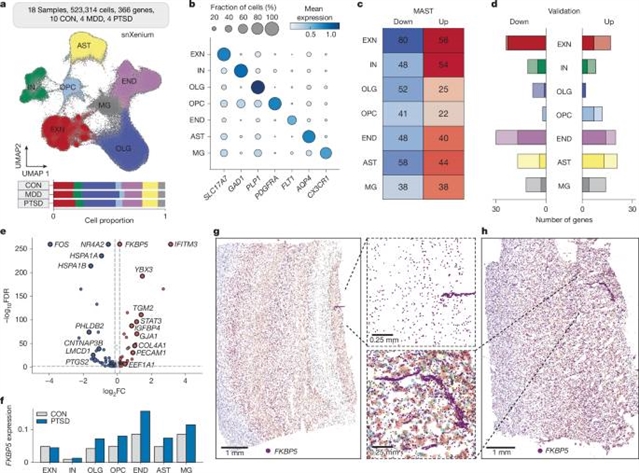
耶鲁大学医学院Matthew J. Girgenti课题组近日取得一项新成果。经过不懈努力,他们揭示了PTSD患者大脑单细胞转录组学和染色质动力学。2025年6月18日,国际知名学术期刊《自然》发表了这一成果。
在这里,该课题组人员从111个人的大脑背外侧前额叶皮层收集了超过200万个核的分子反应,这些核来自于有或没有创伤后应激障碍和重度抑郁症的人的死后。小组鉴定了神经元和非神经元细胞型细胞,基因表达变化和转录调节因子,并以细胞类型特异性的方式绘制了PTSD的表观基因组规律。他们的分析揭示了抑制性神经元、内皮细胞和小胶质细胞中PTSD相关基因的改变,并揭示了与糖皮质激素信号、GABA能传递和神经炎症相关的基因和途径。研究人员进一步验证了这些发现,主题化细胞类型特异性空间转录组学,证实了关键基因如SST和FKBP5的破坏。通过整合遗传学、转录组学和表观遗传学数据,该课题组人员揭示了在细胞类型特异性背景下破坏创伤后应激障碍基因(包括ELFN1、MAD1L1和KCNIP4)的可信变异的调控机制。总之,这些发现提供了细胞特异性分子调控机制的全面表征,该机制是创伤应激反应对人类前额皮质持续影响的基础。
据悉,创伤后应激障碍(PTSD)是一种在极度创伤暴露后发生的多基因疾病。最近的研究已经开始详细研究PTSD的分子生物学。然而,考虑到到目前为止发现的一系列创伤后应激障碍干扰分子途径,单一细胞类型是难以置信的。
附:英文原文
Title: Single-cell transcriptomic and chromatin dynamics of the human brain in PTSD
Author: Hwang, Ahyeon, Skarica, Mario, Xu, Siwei, Coudriet, Jensine, Lee, Che Yu, Lin, Lin, Terwilliger, Rosemarie, Sliby, Alexa-Nicole, Wang, Jiawei, Nguyen, Tuan, Li, Hongyu, Wu, Min, Dai, Yi, Duan, Ziheng, Srinivasan, Shushrruth Sai, Zhang, Xiangyu, Lin, Yingxin, Cruz, Dianne, Deans, P. J. Michael, Huber, Bertrand R., Levey, Daniel, Glausier, Jill R., Lewis, David A., Gelernter, Joel, Holtzheimer, Paul E., Friedman, Matthew J., Gerstein, Mark, Sestan, Nenad, Brennand, Kristen J., Xu, Ke, Zhao, Hongyu, Krystal, John H., Young, Keith A., Williamson, Douglas E., Che, Alicia, Zhang, Jing, Girgenti, Matthew J.
Issue&Volume: 2025-06-18
Abstract: Post-traumatic stress disorder (PTSD) is a polygenic disorder occurring after extreme trauma exposure. Recent studies have begun to detail the molecular biology of PTSD. However, given the array of PTSD-perturbed molecular pathways identified so far1, it is implausible that a single cell type is responsible. Here we profile the molecular responses in over two million nuclei from the dorsolateral prefrontal cortex of 111 human brains, collected post-mortem from individuals with and without PTSD and major depressive disorder. We identify neuronal and non-neuronal cell-type clusters, gene expression changes and transcriptional regulators, and map the epigenomic regulome of PTSD in a cell-type-specific manner. Our analysis revealed PTSD-associated gene alterations in inhibitory neurons, endothelial cells and microglia and uncovered genes and pathways associated with glucocorticoid signalling, GABAergic transmission and neuroinflammation. We further validated these findings using cell-type-specific spatial transcriptomics, confirming disruption of key genes such as SST and FKBP5. By integrating genetic, transcriptomic and epigenetic data, we uncovered the regulatory mechanisms of credible variants that disrupt PTSD genes, including ELFN1, MAD1L1 and KCNIP4, in a cell-type-specific context. Together, these findings provide a comprehensive characterization of the cell-specific molecular regulatory mechanisms that underlie the persisting effects of traumatic stress response on the human prefrontal cortex.
DOI: 10.1038/s41586-025-09083-y
Source: https://www.nature.com/articles/s41586-025-09083-y
Nature:《自然》,创刊于1869年。隶属于施普林格·自然出版集团,最新IF:69.504
官方网址:http://www.nature.com/
投稿链接:http://www.nature.com/authors/submit_manuscript.html
